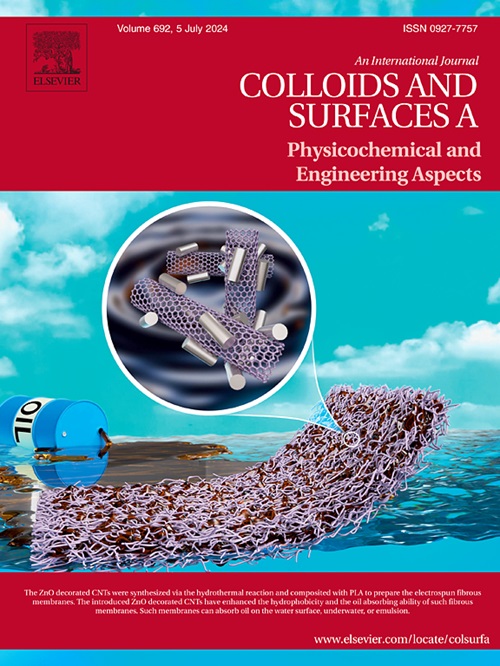Thermal-setting resin-modified silica nanocomposites for self-regenerating and wide plugging distribution in water-based drilling fluids
IF 5.4
2区 化学
Q2 CHEMISTRY, PHYSICAL
Colloids and Surfaces A: Physicochemical and Engineering Aspects
Pub Date : 2025-07-17
DOI:10.1016/j.colsurfa.2025.137780
引用次数: 0
Abstract
Effective pore and fracture plugging typically requires the integration of various types and sizes of particles, ranging from nanoscale to microscale, to minimize drilling fluid invasion into the formation. Here, we report novel thermosetting silica nanoparticles decorated with resin (RSNP), which not only retain their nanoscale distribution even at high temperatures but also promote the formation of micrometer-sized particles through interactions with clay in drilling fluids. Characterizations using Fourier Transform Infrared Spectroscopy (FTIR), Thermogravimetric Analysis and Differential Scanning Calorimetry (TGA-DSC), X-ray Diffraction (XRD), Transmission Electron Microscopy (TEM), and Scanning Electron Microscopy (SEM) were employed to confirm the chemical structure of the synthesized silica nanoparticles and their interaction with clay in the drilling fluid. The plugging effectiveness was systematically assessed using various filter media and natural shale rock samples. TEM and SEM images revealed a narrow, monodisperse particle size distribution of the synthesized silica nanoparticles in the nanoscale, which were found to adsorb on the edges and surfaces of clay lamellae. Original pores and fractures were effectively sealed by silica nanocomposites of comparable size. The strong adsorption of silica nanocomposites on clay particles facilitates clay flocculation in the water phase and expels water molecules from the clay interlayer due to the intercalation and plugging effects of the silica nanocomposites, thereby inhibiting water invasion. Due to the thermosetting nature of the silica nanocomposites, which encapsulate and bridge clay particles at high temperatures, the drilling fluid evolves from a monodisperse to a bimodal particle size distribution, particularly under high-temperature conditions. This transition results in the formation of micrometer-sized particles in water-based drilling fluids, effectively matching the pore and fracture sizes ranging from nanoscale to microscale. These findings offer a novel strategy for designing nanocomposites for multi-stage plugging, optimizing additive usage while minimizing drilling fluid invasion into porous formations.
热固树脂改性二氧化硅纳米复合材料,用于水基钻井液的自再生和宽堵塞分布
有效的孔隙和裂缝封堵通常需要整合各种类型和尺寸的颗粒,从纳米级到微米级,以最大限度地减少钻井液侵入地层。在这里,我们报道了一种新型的热固性二氧化硅纳米颗粒(RSNP),它不仅在高温下保持其纳米级分布,而且通过与钻井液中的粘土相互作用,促进微米级颗粒的形成。利用傅里叶变换红外光谱(FTIR)、热重分析和差示扫描量热法(TGA-DSC)、x射线衍射(XRD)、透射电子显微镜(TEM)和扫描电子显微镜(SEM)对合成的二氧化硅纳米颗粒进行了表征,确定了其化学结构及其与钻井液中粘土的相互作用。采用多种过滤介质和天然页岩样品,系统评价了封堵效果。TEM和SEM图像显示,合成的二氧化硅纳米颗粒在纳米尺度上呈狭窄的单分散粒径分布,吸附在粘土薄片的边缘和表面。原始孔隙和裂缝被同等尺寸的二氧化硅纳米复合材料有效密封。二氧化硅纳米复合材料对粘土颗粒的强吸附,有利于粘土在水相中絮凝,由于二氧化硅纳米复合材料的插层和堵塞作用,使水分子从粘土中间层中排出,从而抑制水的侵入。由于二氧化硅纳米复合材料的热固性,在高温下包裹和桥接粘土颗粒,钻井液从单分散转变为双峰粒度分布,特别是在高温条件下。这种转变导致水基钻井液中形成微米大小的颗粒,有效地匹配了从纳米级到微米级的孔隙和裂缝尺寸。这些发现为多级封堵纳米复合材料的设计提供了一种新策略,优化了添加剂的使用,同时最大限度地减少了钻井液对多孔地层的侵入。
本文章由计算机程序翻译,如有差异,请以英文原文为准。
求助全文
约1分钟内获得全文
求助全文
来源期刊
CiteScore
8.70
自引率
9.60%
发文量
2421
审稿时长
56 days
期刊介绍:
Colloids and Surfaces A: Physicochemical and Engineering Aspects is an international journal devoted to the science underlying applications of colloids and interfacial phenomena.
The journal aims at publishing high quality research papers featuring new materials or new insights into the role of colloid and interface science in (for example) food, energy, minerals processing, pharmaceuticals or the environment.

 求助内容:
求助内容: 应助结果提醒方式:
应助结果提醒方式:


